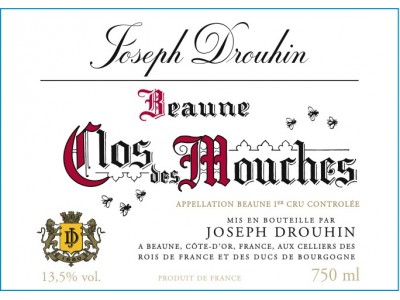
Beaune Clos des MouchesJoseph Drouhin
- Production region Côte de Beaune
- Color Red
- Classification 1er Cru
- Vintage 2021

Grape Variety : Pinot Noir.
Vineyard :
Site : at the southern end of the Beaune appellation, next to Pommard. The Drouhin vineyard is at mid-slope, on a mild incline with an east/south-east exposure. It is the largest parcel in the Clos des Mouches (14 hectares - 35 acres), one half planted with chardonnay, the other half with pinot noir.
History & tradition : the name "mouches" means flies. There were once bee-hives in this sun-drenched "clos" (vineyard enclosure); the bees in the local dialect were called "mouches à miel" (honey flies), hence the name Clos des Mouches. It is one of the first vineyards acquired by Maurice Drouhin (the founder's son) in the 1920's. With great determination, he bought 41 different parcels from 8 proprietors. It is planted equally in red and white grapes and both wines have achieved mythical status for the House of Joseph Drouhin.
Soil : clay and limestone. Rocky soil in the upper part of the vineyard. At the center, the soil is limestone and marl. This light composition is responsible for the great finesse of the wine.
Domaine area : 6.75 ha. (16.875 acres).
Average age of the vines : 39 years.
Viticulture :
Biological cultivation since 1990; biodynamic cultivation a few years later.
Vine stocks : "sélection massale" (propagation of new vine stocks from a number of selected vines) done at the Drouhin nursery; also clones of recognized quality.
Soil maintenance : compost of manure and white wood, sometimes guano (seabird manure used as fertilizer). Soil is ploughed either by tractor or by horse to manage spreading of weeds
Treatment : only authorized products for biological cultivation are used: infusions and macerations of plant materials, sulfur and copper, powdered rock. Natural predators are not eliminated.
Plantation density : from 10,000 to 12,500 stocks/ha in order to extract all possible nuances from the terroir and limit the production of each vine stock.
Pruning : Guyot.
Yield : we aim to keep our yields low, more in line with the previous regulation, around 20% less than allowed by the current law.
Vinification :
Harvesting : by hand, in small open crates in order to preserve the integrity of the fruit.
Sorting of the grapes : in the vineyard and at the cuverie (winery) if necessary.
Maceration : maceration and vinification take 2 to 3 weeksindigenous yeastsmaceration and fermentation temperatures under total controlJoseph Drouhin seeks total control of the process of extraction; extraction gives colour and substance to a wine but should never be detrimental to its finesse and typical character. "Pigeage" (punching down of the cap during fermentation): once a day until half of fermentation is done; one pumping over (remontage) per day till the end of the fermentation.
Pressing : separation of free run juice from pressed juice.
Ageing :
Type : in barrels (20% in new oak).
Length : 14 to 18 months.
Origin of the wood : French oak forests (Tronçay in particular).
Weathering of the wood : Joseph Drouhin insists on total control of the weathering for a period of 3 years, one of the contributing elements to the elegance of the wine. Throughout the ageing process, decisions are taken only after careful tasting evaluation, barrel by barrel. The data obtained is then completed through technical analysis. As with every other Joseph Drouhin wine, absolute priority is given to the true expression of terroir and character of the vintage.
Tasting note by Véronique Boss-Drouhin : "An exceptional wine. Beautiful, deep-red ruby colour, with the bright sheen of great Burgundies. Intense and fresh nose for the young wines. Primary notes of red fruit dominate, such as Morello cherry ("griotte", or wild cherry), raspberry, blackberry. There are hints of complexity with smoky flavours evolving towards liquorice. When the wine is maturing, aromas of pepper, tobacco, humus and undergrowth appear. When drinking the wine, the first impression is always clear-cut and the texture fleshy. The body is firm without being rough, well meshed without being heavy. There is great freshness in the younger wines. With age, the wine gets rounder. It takes on "gras" (velvety texture) and a more precise architecture, supported by silky tannins. It is lively and refined at the same time. There remains a final and most pleasing sensation of harmony, fullness and delicate tannins, as the wine lingers on the palate".
Serving :
Temperature : 16°C (61-62°F).
Cellaring : 5 to 40 years.

Address:Maison Denis Perret
Place Carnot
21200 Beaune
Phone:+33(0)3.80.22.35.47
contact@denisperret.frhuston we have a problem